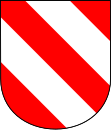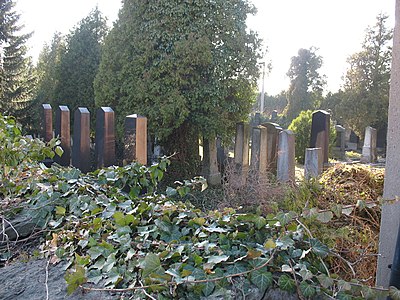Dobruška
| Dobruška | ||||
|---|---|---|---|---|
|
||||
| Basic data | ||||
| State : |
|
|||
| Region : | Královéhradecký kraj | |||
| District : | Rychnov nad Kněžnou | |||
| Area : | 3443 ha | |||
| Geographic location : | 50 ° 18 ' N , 16 ° 10' E | |||
| Height: | 287 m nm | |||
| Residents : | 6,727 (Jan 1, 2019) | |||
| Postal code : | 518 01 - 518 03 | |||
| structure | ||||
| Status: | city | |||
| Districts: | 8th | |||
| administration | ||||
| Mayor : | Petr Lžíčař (as of 2018) | |||
| Address: | nám. FL Věka 11 518 01 Dobruška |
|||
| Municipality number: | 576271 | |||
| Website : | www.mestodobruska.cz | |||
Dobruška (German Gutenfeld ) is a city in the Czech Republic . It is located in Eastern Bohemia in the foothills of the Eagle Mountains , by the Zlatý potok brook . It belongs to the district Rychnov nad Kněžnou in the region Hradec Kralove ( Hradec Kralove ).
history
Dobruška developed from a settlement called Leštno , where important trade routes crossed. In the following years the place was named after the owners of the estate, the lords of Dobruška .
Because of several city fires, only a few sources on the early city history have survived. The first mention comes from the year 1312, when a Johannes de Dobrusca is mentioned. In 1320 Mutina von Dobruška freed the subordinates from compulsory labor and at the same time confirmed their right to brew . During the reign of his son Sezema von Dobruška , the Königgrätzer or Magdeburg town charter was introduced in 1364 . The last owner from the Dobruška family was Johann Městecký von Opočno , who died in 1432. He bequeathed Dobruška to Georg / Jiřík von Dubá on Vízmburk , who linked it with his rule Frymburk . 1455 Dobruška was referred to as an oppidum of the Opočno rule , whose owners from 1495 were the Trčka von Leipa . Under their rule Dobruška experienced an economic boom, which made it a market place for the whole area. Numerous guild privileges have been handed down from this time . After the fire of 1565, the city was rebuilt in the Renaissance style.
After the Hussite Wars , almost the entire population professed Utraquism . At the beginning of the 17th century, Dobruška was a center of East Bohemian Protestantism . In the Thirty Years War , counter-Reformation measures began, which in 1628 resulted in an uprising among the subordinates. Because the followers of the Bohemian Brethren were able to hide in spite of the persecution , Protestant books were publicly burned in 1751. In the course of the re-Catholicization, the deanery church of St. Wenceslas was also rebuilt in baroque style at the beginning of the 18th century .
In the 19th century Dobruška was an East Bohemian center of the Czech national revival ( Obrozeni ), in which the merchant František Vladislav Hek and the chaplain Josef Liboslav Ziegler played an important role. The writer Alois Jirásek created a literary monument to Hek with his five-volume novel FL Věk .
In 1908 Dobruška received a connection to the railway network via the local line Opočno – Dobruschka .
Town twinning
-
 Ábrahámhégy
Ábrahámhégy
-
 County Vale Royal
County Vale Royal
-
 Miejska Górka
Miejska Górka
-
 Radków
Radków
Community structure
The villages of Dobruška include:
- Běstviny ( Biestwin )
- Domašin ( Domashin )
- Chábory ( Habern )
- Spáleniště ( burn hooves )
- Pulice ( Pulitz )
- Mělčany ( Mieltschan )
- Křovice ( Krowitz )
Attractions
- The Renaissance town hall with tower, which stands in the middle of the rectangular market square, was built in the second half of the 16th century.
- The city museum is located in the town hall.
- The originally Gothic parish church of St. Wenceslas ( Kostel svatého Václava ) was modified in Baroque style by M. Rossi in 1709–1725.
- The baroque Marian column was erected in 1733–1736.
- František Vladislav Hek's house
- Renaissance style cemetery chapel
- 17th century Jewish cemetery (one Jewish community has been known since 1545)
- Synagogue built in the 19th century
Surroundings
- Wooden building of a mill from 1816 in the village of Provoz, two kilometers northeast
- The Skalka Castle (five kilometers southeast) was rebuilt in the Baroque style in 1738/39.
Personalities
- František Vladislav Hek (1769–1847), advocate of the Czech national revival
- Josef Mnohoslav Roštlapil (1809–1888), pastor and chronicler of Dobruška
- František Kupka (1871–1957), painter; spent his childhood in Dobruška
- František Adolf Šubert (1849–1915), dramaturge and director of the National Theater in Prague
literature
- Johann Gottfried Sommer : The Kingdom of Bohemia, Vol. 4: Königgrätzer Kreis , Prague 1836, pp. 360–363 digitized
- Joachim Bahlcke , Winfried Eberhard, Miloslav Polívka (eds.): Handbook of historical places . Volume: Bohemia and Moravia (= Kröner's pocket edition . Volume 329). Kröner, Stuttgart 1998, ISBN 3-520-32901-8 .
- Marianne Mehling (Ed.): Knaur's cultural guide in color Czech Republic, Slovak Republic. Droemer Knaur, Munich 1993, ISBN 3-426-26609-1 .
Web links
- http://www.dobruska.cz/historie.html
- http://www.dobruska.cz/muzeum/osobnosti.html
- http://www.g26.ch/art_kupka.html
- virtual show





